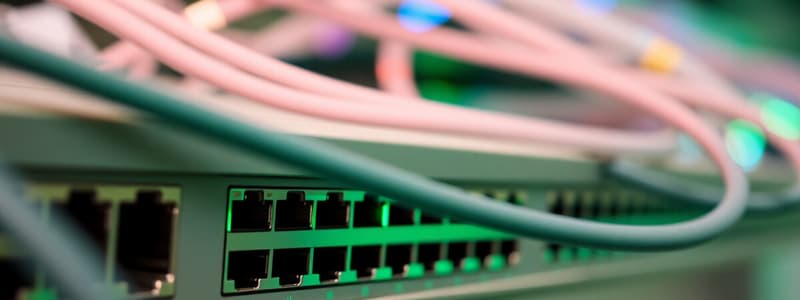Podcast
Questions and Answers
Which layer of the OSI model is responsible for host addressing and routing packets between networks?
Which layer of the OSI model is responsible for host addressing and routing packets between networks?
- Layer 4
- Layer 3 (correct)
- Layer 2
- Layer 7
Which organization manages IP address assignments globally?
Which organization manages IP address assignments globally?
- ICANN (correct)
- ISO
- IETF
- IEEE
What is the maximum decimal value an octet in an IPv4 address can have?
What is the maximum decimal value an octet in an IPv4 address can have?
- 256
- 127
- 254
- 255 (correct)
What is the primary function of a router in a network?
What is the primary function of a router in a network?
Why are MAC addresses only useful within a network segment?
Why are MAC addresses only useful within a network segment?
What is a 'default gateway' in the context of network routing?
What is a 'default gateway' in the context of network routing?
What is a broadcast domain?
What is a broadcast domain?
What operation is used to calculate the network address from an IP address and subnet mask?
What operation is used to calculate the network address from an IP address and subnet mask?
What is the purpose of a subnet mask?
What is the purpose of a subnet mask?
What is the result of a bitwise AND operation between 1101 (13 in decimal) and 1011 (11 in decimal)?
What is the result of a bitwise AND operation between 1101 (13 in decimal) and 1011 (11 in decimal)?
What layer 2 protocol is responsible for finding a host's MAC address when only its IP address is known?
What layer 2 protocol is responsible for finding a host's MAC address when only its IP address is known?
What is the term for a network attack that involves sending out falsified ARP messages?
What is the term for a network attack that involves sending out falsified ARP messages?
Given the IP address 192.168.1.10 and a subnet mask of 255.255.255.0, what is the network address?
Given the IP address 192.168.1.10 and a subnet mask of 255.255.255.0, what is the network address?
Using the IP address 10.0.0.50 and a subnet mask of 255.255.255.0, calculate the broadcast address.
Using the IP address 10.0.0.50 and a subnet mask of 255.255.255.0, calculate the broadcast address.
If a network is using a /24 subnet mask, how many usable host addresses are available?
If a network is using a /24 subnet mask, how many usable host addresses are available?
A host with IP address 172.16.5.25 and subnet mask 255.255.0.0 needs to communicate with a host at 172.16.10.5. Does the traffic need to be routed through a router?
A host with IP address 172.16.5.25 and subnet mask 255.255.0.0 needs to communicate with a host at 172.16.10.5. Does the traffic need to be routed through a router?
What is the result of a bitwise OR operation between 1100 (12 in decimal) and 1010 (10 in decimal)?
What is the result of a bitwise OR operation between 1100 (12 in decimal) and 1010 (10 in decimal)?
Consider the IP address 192.168.5.20 with a subnet mask of 255.255.255.192. What is the maximum number of usable host addresses in this network?
Consider the IP address 192.168.5.20 with a subnet mask of 255.255.255.192. What is the maximum number of usable host addresses in this network?
A router receives a packet with a destination IP address of 10.1.2.5. Its routing table has two entries: 10.1.1.0/24 and 10.1.2.0/24. Which interface will the router use to forward the packet?
A router receives a packet with a destination IP address of 10.1.2.5. Its routing table has two entries: 10.1.1.0/24 and 10.1.2.0/24. Which interface will the router use to forward the packet?
Given the IP address 172.16.3.15 and subnet mask 255.255.240.0, what is the broadcast address for this network?
Given the IP address 172.16.3.15 and subnet mask 255.255.240.0, what is the broadcast address for this network?
What is the decimal equivalent of the binary number 00001111 after applying a bitwise NOT operation?
What is the decimal equivalent of the binary number 00001111 after applying a bitwise NOT operation?
A network administrator configures a router with a default gateway of 192.168.1.1. The router receives a packet destined for 8.8.8.8, but the routing table has no specific route for this network. What will the router do?
A network administrator configures a router with a default gateway of 192.168.1.1. The router receives a packet destined for 8.8.8.8, but the routing table has no specific route for this network. What will the router do?
A network is using the IP address range 192.168.10.0/23. How many usable host addresses are available in this network?
A network is using the IP address range 192.168.10.0/23. How many usable host addresses are available in this network?
Given a host IP address of 10.1.15.66 and a subnet mask of 255.255.255.240, determine the network's valid host IP range.
Given a host IP address of 10.1.15.66 and a subnet mask of 255.255.255.240, determine the network's valid host IP range.
How do routers mitigate the issue of excessive broadcasts in a large network?
How do routers mitigate the issue of excessive broadcasts in a large network?
What is the significance of the network address and broadcast address in an IPv4 network?
What is the significance of the network address and broadcast address in an IPv4 network?
In a routing table, what happens if a router cannot find a specific route to a destination IP address and a 'gateway of last resort' (default gateway) is not configured?
In a routing table, what happens if a router cannot find a specific route to a destination IP address and a 'gateway of last resort' (default gateway) is not configured?
Which of the following describes the operation of a bitwise NOT?
Which of the following describes the operation of a bitwise NOT?
If a packet with a destination IP of 192.168.2.5 arrives at a router, and the routing table contains the entry 192.168.2.0/24, what is the result of the bitwise AND operation between the destination IP and the subnet mask used to determine the route?
If a packet with a destination IP of 192.168.2.5 arrives at a router, and the routing table contains the entry 192.168.2.0/24, what is the result of the bitwise AND operation between the destination IP and the subnet mask used to determine the route?
Assume a network with an IP address of 192.168.4.0 and a subnet mask of 255.255.255.224. How many hosts would be required to exhaust half of the available assignable IP addresses?
Assume a network with an IP address of 192.168.4.0 and a subnet mask of 255.255.255.224. How many hosts would be required to exhaust half of the available assignable IP addresses?
A network engineer has assigned an IP address of 172.16.31.255 with a subnet mask of 255.255.240.0 to a server. Upon attempting to connect to this server, other hosts on the 172.16.0.0/16 network report intermittent connectivity issues. What is the most likely cause of this problem?
A network engineer has assigned an IP address of 172.16.31.255 with a subnet mask of 255.255.240.0 to a server. Upon attempting to connect to this server, other hosts on the 172.16.0.0/16 network report intermittent connectivity issues. What is the most likely cause of this problem?
In a complex network, a router receives a packet with a destination IP of 10.45.12.17. Its routing table contains the following entries:
- 10.45.0.0/16, next hop: 192.168.1.1
- 10.45.12.0/22, next hop: 192.168.2.1
- 0.0.0.0/0, next hop: 192.168.3.1
Which next hop will the router choose for this packet?
In a complex network, a router receives a packet with a destination IP of 10.45.12.17. Its routing table contains the following entries:
- 10.45.0.0/16, next hop: 192.168.1.1
- 10.45.12.0/22, next hop: 192.168.2.1
- 0.0.0.0/0, next hop: 192.168.3.1
Which next hop will the router choose for this packet?
An engineer needs to subnet a /24 network into multiple subnets, each capable of hosting exactly 6 usable hosts. What subnet mask is the SMALLEST which meets this?
An engineer needs to subnet a /24 network into multiple subnets, each capable of hosting exactly 6 usable hosts. What subnet mask is the SMALLEST which meets this?
Flashcards
Internet Protocol Version 4 (IPv4)
Internet Protocol Version 4 (IPv4)
Layer 3 protocol providing global addressing for data transmission between hosts on different networks.
Router
Router
A network device that forwards data packets between different networks.
Broadcast Domain
Broadcast Domain
The area over which a broadcast message can be propagated in a network.
Routing Table
Routing Table
Signup and view all the flashcards
Subnet Mask
Subnet Mask
Signup and view all the flashcards
Bitwise AND
Bitwise AND
Signup and view all the flashcards
Bitwise OR
Bitwise OR
Signup and view all the flashcards
Bitwise NOT
Bitwise NOT
Signup and view all the flashcards
Network Address
Network Address
Signup and view all the flashcards
Broadcast Address
Broadcast Address
Signup and view all the flashcards
IP Range
IP Range
Signup and view all the flashcards
Gateway
Gateway
Signup and view all the flashcards
Route Table Rules
Route Table Rules
Signup and view all the flashcards
Gateway of Last Resort
Gateway of Last Resort
Signup and view all the flashcards
Study Notes
- Layer 3 protocols handle host addressing and packet routing between networks in the OSI model.
- Internet Protocol version 4 (IPv4) and Address Resolution Protocol (ARP) are layer 3 protocols.
Internet Protocol Version 4 (IPv4)
- IPv4 is a popular layer 3 protocol that facilitates global addressing, allowing hosts to send data across the world.
- IPv4 addresses are represented in dotted decimal notation (e.g., 192.168.0.1), with each number being an octet (8-bit byte) that does not exceed 255.
- The Internet Corporation for Assigned Names and Numbers (ICANN) manages IP address assignments.
- IPv4 operates within layer 2 protocols like Ethernet, with layer 3 packets being the ‘data’ within the frame.
Router
- Routers prevent the issues of having all hosts in a single network broadcast, like ARP poisoning which is when hackers impersonate servers and collect confidential data, and the waste of network capacity.
- Routers are networking devices that have different MAC and IP addresses on each port.
- Routers make complex networking decisions based on IP addresses and enforce security rules.
- Routers have fewer ports than switches and do not forward broadcasts or ARP messages.
- Routers operate in network segments and have configurable ports with unique MAC and IP addresses.
- Routers direct packets based on the destination IP address.
Broadcast Domain
- A broadcast domain is the area where a broadcast message propagates, similar to the collision domain concept.
- Routers break up broadcast domains, preventing messages from crossing between segments.
- MAC addresses are only functional within a network segment.
- Routers handle ARP by receiving messages, determining the appropriate port, and performing ARP in the destination segment.
- Hosts determine if a packet needs to be sent via a router, relying on a routing table.
Networks With Multiple Routers
- If the target host is in the same segment, it can be sent directly but If not, it needs to go via the router.
- Routing tables contain a list of known networks and their corresponding routers, including a default gateway for unknown routes.
Subnet Masks
- Subnet masks indicate if an IP address is within a specific network segment.
- Subnet masks define IP address ranges using bitwise OR, AND, and NOT functions.
- Bitwise AND compares bits and returns 1 if both are 1, otherwise 0.
- Bitwise OR returns 1 if either or both bits are 1, otherwise 0.
- Bitwise NOT inverts bits (1 becomes 0, and 0 becomes 1).
- The network address, which is the first IP address of the network, is calculated by performing a bitwise AND of the IP address and the mask.
- Subnet masks are often represented with a slash followed by the number of 1s (e.g., /24).
Broadcast Address Calculation
- The broadcast address, which is the highest IP address in a network, is reserved and sends data to all hosts.
- To calculate the broadcast address, invert the subnet mask bits and perform a bitwise OR with the IP address.
IP Range
- For an IP address of 192.168.0.11 with a mask of 255.255.255.0 (/24):
- The highest IP address (broadcast address) is 192.168.0.255.
- The lowest IP address (network address) is 192.168.0.0.
- The maximum number of IP addresses is 256 – You can have 254 hosts in the network because the first and last IP addresses are reserved.
- The number of addresses = 2^(32-MaskBits)
Network Configuration
- Hosts and routers are configured with IP addresses, subnet masks, and default gateways.
- Routers use routing tables to make decisions on where to send packets.
- If no match is found, the packet is sent to the gateway of last resort (the default gateway). If the gateway of last resort is not set, the packet is discarded.
- Routers read every rule in its route table until it finds a match.
- Use bitwise AND with the target IP address to check if the first rule matches the destination IP address.
Studying That Suits You
Use AI to generate personalized quizzes and flashcards to suit your learning preferences.



